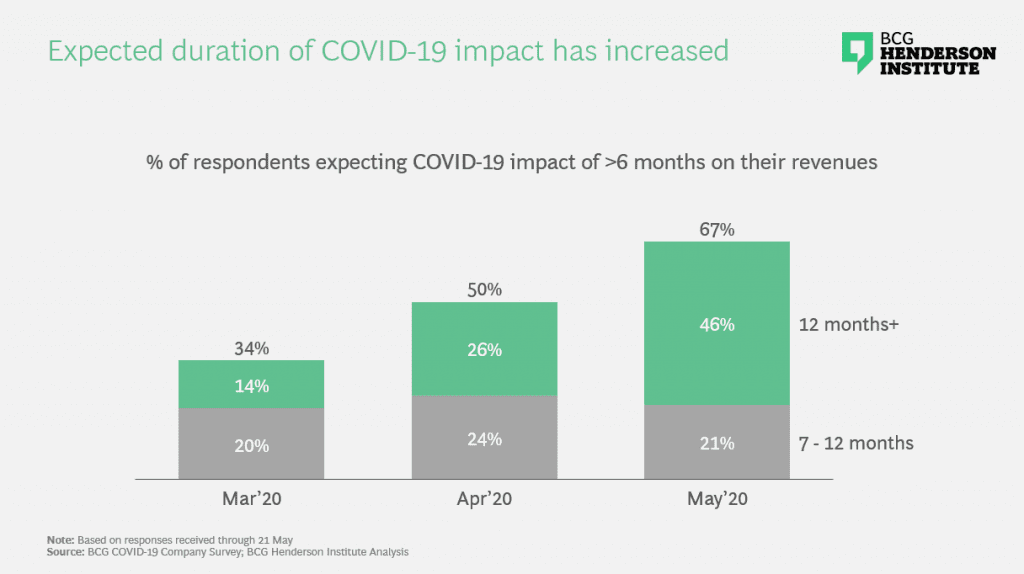One of the most common questions managers ask about the COVID-19 crisis is, “When will it be over?” The question reflects an understandable fatigue with living under protracted uncertainty and a desire to return to normalcy. But not only are we unlikely to return to the pre-crisis normal, it could also be quite some time until we reach a new steady state and uncertainty abates. It’s even possible that there may be no prolonged equilibrium before the next disruption. How, then, can leaders address a rising sentiment of impatience and foster the stamina required for organizations to successfully adapt to new conditions?
A long journey
While we can’t be sure when the outbreak will be resolved, it seems likely that it could be protracted. Cumulative case numbers are plateauing in many nations, but the epidemic continues to spread in others. Furthermore, the disease may not end with the first cycle; epidemiologists warn that the disease could exhibit a second wave, as many viral outbreaks have historically had, or could even become endemic, like the seasonal flu. Uncertainty about the disease is likely to persist until at least the widespread deployment of a vaccine, which is not expected until sometime next year in even the most optimistic scenario.
As a result, uncertainty will persist in our everyday lives. For example, hundreds of epidemiologists recently surveyed by the New York Times gave a wide spread of opinions on when they would be comfortable resuming common activities. A majority said it would take anywhere from 3–12 months before they would feel comfortable going to work in an office or eating at a sit-down restaurant, and most said it would be more than a year before they would attend a sporting event or performance.
Economic uncertainty is also unlikely to disappear quickly. The National Bureau of Economic Research recently confirmed that the US economy is in recession and the World Bank predicts a 5.2% contraction in global GDP in 2020. Cautious consumers are likely to prolong the period of economic uncertainty and adjustment and unemployment and bankruptcies could have lasting economic effects.
And both the disease and the recession have had created broader impacts across society, bringing concerns about inequality and justice to the forefront. The recent wave of protests in the US and some other countries will likely also have some lasting impact which shapes both policies and consumer behaviors.
It is not surprising therefore that many businesses are increasingly envisioning a long period of uncertainty. According to our survey of hundreds of companies across countries and sectors, as of March only 14% of companies expected COVID-19 to affect their business for more than 12 months — but by May that share had more than tripled to 46%. And whereas in the early months of the crisis, only 20–30% of companies expected to make permanent changes in their supply chains, marketing activities or sales channels, by May that share had doubled to 40–60%.

Stamina pays off in crises
Many companies are likely to face challenging, volatile circumstances for the foreseeable future. However, crises also create opportunities for some: our research shows that 10–20% of companies in each sector increase their absolute performance during downturns.
Such “flourishers” demonstrate a very characteristic pattern of behavior. Despite the challenging circumstances, top performers obtain most advantage through differential growth rather than more immediate differential efficiency gains. And they are more likely to take a long-term orientation, focusing not only on day-to-day operational challenges but also on the future of their business. To realize that future, many companies will need to undergo transformation programs that often require significant time and investment. These findings point to a roadmap for success in a crisis that depends not only on the immediate gratification of cost reduction, but on a longer, slower path of growth and reinvention — which requires organizational stamina.
Yet prolonged crises like COVID-19 can easily cause individuals to lose stamina and dilute the initial zeal and engagement which a crisis can mobilize. This can occur in a number of ways:
- Loss of energy. The early stages of the outbreak were characterized in many companies by hyperactivity: Newly formed crisis response teams met daily, contingency plans were developed and executed, and frequency of communication accelerated dramatically — all on top of the company’s existing operations. These activities were necessary to adapt to rapidly unfolding events, but when the crisis did not disappear but instead became a semi-permanent fixture, individuals continuing to deal with the new uncertainties risk burning out and losing energy.
- Loss of novelty. Our brains are wired to attend to novel or unexpected phenomena, and after several months of COVID-19 redefining so much of our business and personal activities, the novelty has worn off. Even though the crisis continues to pose significant challenges to companies, employees risk losing attention and becoming distracted. Strange that it may sound, it is entirely possible to become bored with a crisis, even one with fatal consequences.
- Loss of belief. Persevering against an ongoing challenge requires a conviction that the goal is achievable and your efforts are creating movement towards it. During the depths of a crisis, individuals may lose motivation if they don’t see tangible progress resulting from their work. In some industries and companies, rebound may come slowly, and employees can lose hope.
- Loss of focus. The health and economic effects of the crisis have likely affected everyone in some way, and the stress of continued uncertainty about the future will continue weighing on people for the foreseeable future. Initially this may have been offset by increased adrenaline, but as that fades and the crisis persists, focusing on the task at hand becomes more challenging.
The recipe for stamina
How then can leaders build stamina in the face of fatigue brought about by protracted stress and uncertainty? From our research on attaining advantage in adversity and from our observations during the current unfolding crisis, we suggest six factors:
- Communicate a credible vision. In times of crisis, employees increasingly turn to leaders for guidance and direction. While many tactical matters have to be communicated, such as reopening plans, hygiene policies, and business updates, leaders should not let those crowd out the bigger picture. Articulating a renewed vision of success for the company, and a path to achieving it, will help workers stay engaged.
- Build confidence with early gains and leading indicators. Once they have a compelling goal, employees will need to see that their efforts are creating progress toward achieving it. In challenging economic circumstances, this will not always show up immediately in traditional financial metrics, which are inherently backward-looking. Instead, leaders need to measure the leading indicators that are directly relevant to the change agenda — and thus make more visible the progress being made.
- Set a sustainable pace. We know that speed of decision making and action matters — transformation programs taken earlier achieve better results. However, persistent change and uncertainty can cause a feeling that there is always more that can be done — and trying to manage too many variables risks burning out staff and managers. Leaders need to identify the real priorities and remove unnecessary or duplicative work in order to keep the organization in it for the long haul. Ultimately this depends on identifying new growth drivers and definitively shifting resources and attention to support their success, rather than supporting too many initiatives.
- Evolve the focus of efforts over time. The COVID-19 crisis has presented challenges on multiple timescales, from reacting to the initial outbreak and shutdowns, to preparing for possible rebound, to preparing for the recession and recovery, to reimagining the business for the longer run. By shifting the focus to different challenges over time, companies can keep the task at hand fresh and avoid getting stuck in a rut. Furthermore, these different challenges require different types of problem-solving approaches, again arguing for a shifting, multi-phased approach rather than a long slog.
- Reorient toward growth and innovation. While often necessary, cost-cutting and crisis management are rarely inspiring — and in the long run, a company’s performance is driven to a much greater degree by growth and reinvention. By orienting the challenge towards exploiting new possibilities, leaders can unlock employees’ imagination and foster a sense optimism and control in shaping what will happen next.
- Show empathy and maintain cohesion. In times of personal uncertainty and social instability, all employees need to know that they are supported and they need to feel part of the collective effort, in spite of geographic remoteness and increased stress in their personal lives. Especially now, leaders need to be authentic and visible — going beyond stiff, formal statements and instead speaking personally and honestly, in ways that create credibility, trust and affiliation.
COVID-19 and its effects will be with us longer than we wish — it won’t soon “all be over”. The companies that emerge strongest are likely to frame it as an enduring challenge and address it accordingly. By helping preserve energy, novelty, motivation, and peace of mind, leaders can build the stamina in their organizations to see that process through. For those companies, a war of attrition will give way to the flourishing of new opportunity.



